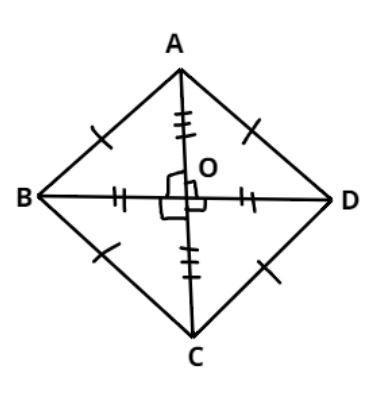
If the diagonals of a quadrilateral bisect each other at right angles, then it is a
$A.$ Trapezium
$B.$ Parallelogram
$C.$ Rectangle
$D.$ Rhombus
Answer
607.2k+ views
Hint: In this Question first draw the diagram it will give us a clear picture what we have to prove and diagonals of this quadrilateral bisect each other at right angles (i.e. it cuts the diagonals into two equal parts) later on apply the property of Pythagoras Theorem so, use these concepts to reach the solution of the question.

Let ABCD be a quadrilateral as shown above.
And it is given that the diagonals of this quadrilateral bisect each other i.e. it is perpendicular to each other, (i.e. it cuts the diagonals into two equal parts).
$
\Rightarrow OB = OD,{\text{ \& }}OA = OC..................\left( 1 \right) \\
\angle AOB = \angle AOD = \angle BOC = \angle DOC = {90^0} \\
$
So in triangle AOB apply Pythagoras Theorem
${\left( {{\text{Hypotenuse}}} \right)^2} = {\left( {{\text{Perpendicular}}} \right)^2} + {\left( {{\text{Base}}} \right)^2}$
$ \Rightarrow {\left( {AB} \right)^2} = {\left( {OA} \right)^2} + {\left( {OB} \right)^2}$…………. (2)
Now from figure $AC = OA + OC,{\text{ }}BD = BO + OD$
From equation (2)
$
AC = OA + OA,{\text{ }}BD = OB + OB \\
\Rightarrow OA = \dfrac{{AC}}{2},{\text{ }}OB = \dfrac{{BD}}{2} \\
$
Now from equation (2)
$
\Rightarrow {\left( {AB} \right)^2} = {\left( {\dfrac{{AC}}{2}} \right)^2} + {\left( {\dfrac{{BD}}{2}} \right)^2} \\
\Rightarrow {\left( {AB} \right)^2} = \dfrac{{{{\left( {AC} \right)}^2}}}{4} + \dfrac{{{{\left( {BD} \right)}^2}}}{4} \\
$
$ \Rightarrow 4{\left( {AB} \right)^2} = {\left( {AC} \right)^2} + {\left( {BD} \right)^2}$…………………….. (3)
Similarly,
$ \Rightarrow 4{\left( {BC} \right)^2} = {\left( {AC} \right)^2} + {\left( {BD} \right)^2}$……………………… (4)
$ \Rightarrow 4{\left( {CD} \right)^2} = {\left( {AC} \right)^2} + {\left( {BD} \right)^2}$………………………… (5)
$ \Rightarrow 4{\left( {DA} \right)^2} = {\left( {AC} \right)^2} + {\left( {BD} \right)^2}$…………………………… (6)
Now from equation (3), (4), (5) and (6)
AB = BC = CD = DA
Therefore all the sides of a quadrilateral becomes equal and the diagonals bisect at right angle,
Which is the condition of rhombus.
So, the given quadrilateral whose diagonals bisect each other at right angles is a rhombus.
Note: In such types of questions the key concept we have to remember is that always recall the property of rhombus which is in a rhombus all sides are equal and its diagonal always bisect each other at right angles, then we prove this property for the given quadrilateral whose diagonals bisect at right angle, by using the property of Pythagoras Theorem as above and simplify, we will get the required answer.

Let ABCD be a quadrilateral as shown above.
And it is given that the diagonals of this quadrilateral bisect each other i.e. it is perpendicular to each other, (i.e. it cuts the diagonals into two equal parts).
$
\Rightarrow OB = OD,{\text{ \& }}OA = OC..................\left( 1 \right) \\
\angle AOB = \angle AOD = \angle BOC = \angle DOC = {90^0} \\
$
So in triangle AOB apply Pythagoras Theorem
${\left( {{\text{Hypotenuse}}} \right)^2} = {\left( {{\text{Perpendicular}}} \right)^2} + {\left( {{\text{Base}}} \right)^2}$
$ \Rightarrow {\left( {AB} \right)^2} = {\left( {OA} \right)^2} + {\left( {OB} \right)^2}$…………. (2)
Now from figure $AC = OA + OC,{\text{ }}BD = BO + OD$
From equation (2)
$
AC = OA + OA,{\text{ }}BD = OB + OB \\
\Rightarrow OA = \dfrac{{AC}}{2},{\text{ }}OB = \dfrac{{BD}}{2} \\
$
Now from equation (2)
$
\Rightarrow {\left( {AB} \right)^2} = {\left( {\dfrac{{AC}}{2}} \right)^2} + {\left( {\dfrac{{BD}}{2}} \right)^2} \\
\Rightarrow {\left( {AB} \right)^2} = \dfrac{{{{\left( {AC} \right)}^2}}}{4} + \dfrac{{{{\left( {BD} \right)}^2}}}{4} \\
$
$ \Rightarrow 4{\left( {AB} \right)^2} = {\left( {AC} \right)^2} + {\left( {BD} \right)^2}$…………………….. (3)
Similarly,
$ \Rightarrow 4{\left( {BC} \right)^2} = {\left( {AC} \right)^2} + {\left( {BD} \right)^2}$……………………… (4)
$ \Rightarrow 4{\left( {CD} \right)^2} = {\left( {AC} \right)^2} + {\left( {BD} \right)^2}$………………………… (5)
$ \Rightarrow 4{\left( {DA} \right)^2} = {\left( {AC} \right)^2} + {\left( {BD} \right)^2}$…………………………… (6)
Now from equation (3), (4), (5) and (6)
AB = BC = CD = DA
Therefore all the sides of a quadrilateral becomes equal and the diagonals bisect at right angle,
Which is the condition of rhombus.
So, the given quadrilateral whose diagonals bisect each other at right angles is a rhombus.
Note: In such types of questions the key concept we have to remember is that always recall the property of rhombus which is in a rhombus all sides are equal and its diagonal always bisect each other at right angles, then we prove this property for the given quadrilateral whose diagonals bisect at right angle, by using the property of Pythagoras Theorem as above and simplify, we will get the required answer.
Recently Updated Pages
Two men on either side of the cliff 90m height observe class 10 maths CBSE

What happens to glucose which enters nephron along class 10 biology CBSE

Cutting of the Chinese melon means A The business and class 10 social science CBSE

Write a dialogue with at least ten utterances between class 10 english CBSE

Show an aquatic food chain using the following organisms class 10 biology CBSE

A circle is inscribed in an equilateral triangle and class 10 maths CBSE

Trending doubts
Why is there a time difference of about 5 hours between class 10 social science CBSE

Write a letter to the principal requesting him to grant class 10 english CBSE

What is the median of the first 10 natural numbers class 10 maths CBSE

The Equation xxx + 2 is Satisfied when x is Equal to Class 10 Maths

Which of the following does not have a fundamental class 10 physics CBSE

State and prove converse of BPT Basic Proportionality class 10 maths CBSE




